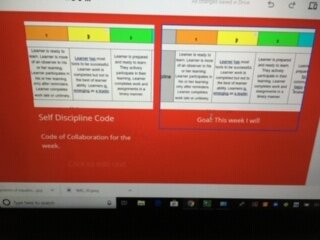Leading With Grace and User-Centeredness During Coronavirus: A Lindsay Unified School

In this interview with Cindy Alonzo, Principal of Reagan Elementary, a K-8 in the 100% Title 1 Lindsay Unified School District in central California, we explore how a learner-centered district becomes even more strongly learner-centered through the disruption of the pandemic.

Before the Crisis
Transcend: As we saw in our interview with Melissa Hawkins last month, Lindsay Unified has been going deep with personalized learning for many years. Can you tell us what that looked like from a school leader’s perspective?
Cindy Alonzo: We were feeling really good about where we were as a site. We had many of our pieces in place in regard to our district-wide vision of an ideal learning experience. We were meeting learners’ needs in whole group and small group instruction. We did blended learning, hitting math very directly, and ELA in an integrated way. Tools like iReady and ReadingPlus let us create groups that met learners where they were. We were feeling strong about the testing season and looking forward to spring and lots of HSS/science fun stuff. We were using some project-based learning in the spring and developing a lot of real life projects linked to lifelong learning.
Then, within a week, everything flipped.
During the Crisis
Transcend: What did you notice?
What was the new normal going to be? How were we going to do those tightly controlled things that had let us meet learners where they were? How do you instruct in this new realm?
Cindy Alonzo, Principal
CA: We were used to controlling all the elements; we controlled the school day–making sure it was rich and developing. And now, what was the new normal going to be? How were we going to do those tightly controlled things that had let us meet learners where they were? How do you instruct in this new realm?
Transcend: So you started by surfacing powerful questions, not just putting solutions in place.
CA: Yes, and our staff truly rose to the occasion. We stepped back and said to our learning facilitators, “Get connected with one or two tools for this new environment that you can get comfortable with. Get really good at one thing–e.g. Google Classroom. While you’re doing that, build connections and relationships with your learners, some of whom were in a place of trauma even before the crisis hit.” School was the safe zone for many of our learners, and now it was gone, and their parents were being laid off.
Transcend: How did your staff respond?
CA: Tech isn’t my leading strength so my learning facilitators stepped in and helped each other. My job was to coordinate and facilitate as they supported each other in learning the tech tools.
Transcend: What about the Central Office?
We’ve been asking for years, “Are we providing motivating learning opportunities?” But now the question is “What do those look like in an electronic world?”
CA: They’ve been amazing! Within 48 hours Melissa Hawkins had put together a basic sheet of websites for teachers and parents. Amalia Lopez has created amazing training. Tom Rooney, our superintendent, has set the direction for us all: learning has not stopped–and the Central Office is here to support you. The biggest shoutout goes to the tech department–by spring break (two weeks into the building closures) 90% of our learners had a device and were ready to go.
Transcend: Let’s talk about some of the main challenges.
CA: Working from home is a whole different ball game–for our learners, for staff, for me. We’ve been asking for years, “Are we providing motivating learning opportunities?” But now the question is “What do those look like in an electronic world?” We had always had so much control over the learning environment, and now we don’t, so we’re asking ourselves, “How we can support learners doing more on their own, with less guidance from us? What do those structures look like? What does greater autonomy mean in learning design?”
Transcend: It’s remarkable how deeply user-centered design is embedded in your culture. You always seem to start with questions, not solutions!
CA: That’s how you learn, right? I know I don’t have all the expertise. I need to learn too. When all this happened, I called one of my best friends who is a homeschool teacher. I said to her, “Walk me through a day and week for you so I can understand what it looks like.” She gave me some good specific ideas.

Transcend: Can you share some of them?
CA: Sure. She gave me two big takeaways: be flexible and shift your expectations.
- Develop a home schedule for yourself (and allow yourself flexibility): When will your office hours be? Should they vary at different times on different days for different people? How will you communicate that with parents? And even then, after all that, make sure you’re flexible even with the plans.
- Don’t expect learners to do the same amount of work they would do at school.
From that base, I began to ask a bunch more questions as we embarked on our remote learning journey.
- What should be the expectations for different level learners? Content Level 1 vs Level 7?
- How might you build systems for learners who are not connecting?
- We have wifi, tech, and 1:1 but we have learners and parents not in that place–how might we work with those parents and learners?
- Maybe a digital format isn’t going to work with those learners–so what else could we do?
We’re still building these systems–they’re still very dynamic.
learnings
Transcend: What other learning design questions are you grappling with?
CA: We’re working on what to do when the work is too much or too difficult given what’s happening at home. For example, what if the parents are essential workers, and there’s a babysitter with the learners all day, and the parents aren’t comfortable sending the technology to the babysitter’s place? How can we provide different opportunities? We also don’t want to dramatically impact home life–we need to be family-centered. So how do we support the less than 10% of learners who only will have 2 hours per day to get support?
Some of our older learners are working a full day in the fields. Can someone be available in the evening when they come home? The way we’re designing learning environments is very dynamic because our learners’ and families’ needs are very dynamic.
Transcend: That’s incredible agility. Let’s talk about growth. Another hallmark of Lindsay’s culture seems to be that everyone is a learner, including adults.
CA: That’s one of the main questions I’m thinking about: When we come out of this and into recovery, what were we able to learn about our learners and ourselves during this time?”
Transcend: Do you have some preliminary ideas? Let’s start with you. What did you learn?
This made me think about how I create a culture and systems that provide grace and understanding and space for vulnerability—as well as sharing of expertise.
CA: I was very comfortable with my leadership. I know my people, and I knew they would think about our learners first. Still, this was a completely different ballgame. Within 48 hours, we went from thinking about closing to closing. I’m not sure I’m comfortable with the uncertainty. I had to deal with that. I had thought about building systems for this new tech world—and as I said earlier, I’m not the most tech savvy person. Then I realized this was something many of us faced. Not all of us are strong in this area, and at the same time some of us are very tech savvy. This made me think about how I create a culture and systems that provide grace and understanding and space for vulnerability—as well as sharing of expertise. So that people who want to fly have the freedom to fly, and people who need support have the trust to ask for it. I learned how to combat perfectionism–how to help people not compare themselves to each other (‘She’s so much better at tech than I am”) and instead create the grace to learn.
Transcend: What were some of the outcomes of this culture of grace?
CA: Our collective efficacy has been strengthened—from relying on each other so much. Our staff has grown so much in terms of relationships; we were collaborative before but people would still shut their doors and do their thing. Now collective empathy is real.
Transcend: What about your learners?
CA: We’re beginning to understand how learning can extend beyond the school day—and not just for our 3rd through 8th content level learners. Before closure, we did not send technology home with our younger learners. Because of this, parents had to build protocols at home for learners to use the technology. Some parents could not help their children to maneuver the use of the new tech to learn or engage in learning. This was clearly a mistake on our part. I’m hoping this is a lesson we take forward as we return to the regular routine.
Going forward, we plan to be able to meet all our learners where they are.
Cindy Alonzo has been the Principal of Reagan Learning Community in Lindsay, California for the past three years. Ms. Alonzo has been in education since 1995 and has experience at all levels—elementary, middle and high school. She has served in the capacity of learning facilitator, assistant principal, and site Principal.
Transcend supports communities to create and spread extraordinary, equitable learning environments.

